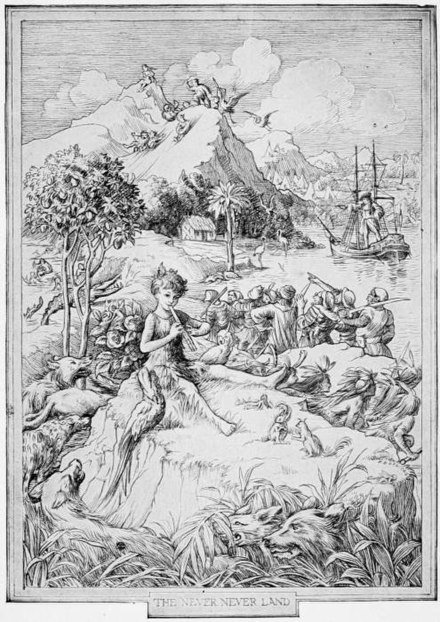The Evolution of Fae
Defining and Contextualizing Fae
According to Britannica, fae are “mythical beings of folklore and romance usually having magic powers and dwelling on earth in close relationship with humans.” This seems to be a very broad definition, but that is largely due to the fact that the term fae, even in its origin, was used to describe many different things. It’s easy to forget that today’s fae actually originated hundreds of years ago with European mythology. Below is a list of some of the creatures that fall under the umbrella of fae, though for the purposes of this post, I’ll be primarily using the words “fae” and “fairy”.
Some of these examples are still used in literature today, while others have been completely forgotten by modern society, but they all played a critical role in establishing the world of fae. An especially important precursor to understanding the growth of fae in society is the Aos sí of Celtic mythology, which illustrate the core beliefs that existed at the time and have the most direct connection to the present.
Developments in Europe– Aos Sí
The Aos sí were the supernatural race of fae in Celtic mythology. This race was said to have descended from Tuatha De Danann, or The People of the Goddess Danu, who were the original fairy group. Fairies in this group did not die, had magical abilities, and often played tricks on ordinary people to prove their superiority.
Physically, the Aos sí did not fit one singular description. There was so much variation among different creatures within the group that some were said to look like very attractive men and women, while others looked like elves and animals. Only a few general characteristics applied to the majority, such as a strong connection to nature. Many of these fae were physically very related to animals, often having tails and snouts. The strongest example of this would be the Cait-Sìth, or the Faerie Cat, who is believed to curse people who do not leave a saucer of milk out as an offering. Others can control nature, like the alp-luachra, a type of sprite that waits for humans to fall asleep next to bodies of water, where they can then turn into a newt and crawl into the human’s mouth to cause various internal ailments.
But the fae were not always so merciless.
Even the most hostile forms of fae could fall in love with mortals. Their trickery was not due to any sort of hatred, but simply a differing value system. This cultural variation is most illustrated through the popular advice to never thank a fae because it implies a debt between the two parties. Though the fae were not always said to do cruel things to humans, the negative stories overwhelmed the hopeful ones, and any positive connotation the fae had at this time was thought to come second to all the abominable things they did.
The Aos sí were an incredibly important part of Irish culture in the 1800s. According to folklore historian Simon Young, “There was the belief among some Irish potato growers that it was the fairies’ disfavour that brought down the blight on the land. Fairy battles in the sky – fairy tribes both fought and played hurling matches against each other – were interpreted as marking the onset of the famine: a victorious fairy army would curse the potatoes of the enemy’s territory.” The Aos sí were also said to need human women to act as midwives when they gave birth, reflecting the critical role and value given to women who took care of children in the 1800s. They were also said to be repelled by the Bible and anything related to Christianity in general, which mirrors the importance given to Christianity at that time in Ireland.
Other historical ideas of what repels the fae from, like the use of iron or steel to take away their magic, can be seen carrying on in today's novels. However, this is not the only example of fae history continuing into our present culture. Another example is October 31st, Halloween, which is said to be a time when the tricks done by the Aos sí were heightened because “the ethereal wall between the human world and the fairy world is at its thinnest”. These ideas appear in many different examples of media throughout history.
A More Modern Rendition
With all of this rich folklore established in Ireland, a new type of fairy was beginning to develop in Scotland. In 1904, Scottish playwright J.M. Barrie wrote a play called Peter Pan, which was the first introduction to Tinker Bell. When looking at the demeanor and characteristics of Tinker Bell, there is a clear connection to the traits of the fae that came before her. Tinker Bell in the play is vindictive due to her jealousy of Wendy, while simultaneously showing kindness and affection towards Peter. Similar to the old Irish fae, Tinker Bell has some positive qualities, but there are times when her negative qualities are overwhelming exemplifying the dichotomy of fae in mythology.
While Tinker Bell shares many internal characteristics with old fae, her physical characteristics are unique. Tinker Bell’s nature was explained originally by the fact that she was incredibly small, and could therefore only feel one emotion at once. Physically, Tinker Bell was not only small, but had wings and only spoke in sounds of a tinkling bell, which contrasts greatly with the fae of the past. When looking at the entirety of Tinker Bell, it seems that she was partly due to the history of Celtic fae in mythology and partly due to J.M. Barrie’s creative mind.
Fae Fantasies Today: A Reader’s Perspective
The physical traits of old fae do not reappear in history until the rise of fantasy novels based on them, mainly from Celtic mythology. Two fantasy authors who have written famous examples of these novels are Sarah J. Maas and Holly Black. Maas’ biggest series begins with A Court of Thorns and Roses (ACOTAR), and is arguably the first major fantasy series that is fully based in a world of fae. Just a few years later, Black released the first book in her series, The Cruel Prince (TCP). Though The Cruel Prince comes later, it consists of a fae world system that is tonally very contrasting to ACOTAR, so an analysis of both of these books provides a more complete overview of the state of fae current storytelling.
Both series center around the relationship between humans and fae, likely to maintain relatability of the main character and to help readers feel like they can see themselves in the story. ACOTAR is about a human girl named Feyre who is taken to the fae world as retribution for killing one of their kind. She consequently goes through many hardships to eventually find love. In contrast, TCP is about a human girl named Jude who is taken to the fae world as a child after her parents are murdered by her mother’s former fae lover. The book delves into her struggles being raised human amongst her fae peers.
Though ACOTAR and TCP are often compared, I would argue they truly shouldn’t be considering they have two completely different purposes. ACOTAR is a romance, and its main goal is to show the romantic development of characters with the plot being used as a device to move this romance along. In contrast, TCP is a political fantasy, delving into the different decisions and motivations that characters have to maintain power. The romance in TCP is only a subplot, and isn’t necessarily the main focus of the book the way it is in ACOTAR.
Now that the clear difference between these two books has been established, we can delve into how they both portray fae.
In ACOTAR, there is a hierarchy consisting of High Fae and lesser fae. The High Fae are described as being human-like, but are taller and more attractive than mortals. The lesser fae are described more like animals or otherworldly creatures. For example, water wraiths in ACOTAR, which are based on creatures from Scottish mythology, are written to have gray skin, wholly black eyes, and gills near their ears. Maas explains in her work that everything the humans believe about fae (their aversion to iron, their inability to lie, etc.) was made up by the fae to scare them. This choice reveals how heavily Maas borrowed from Celtic myths for her world-building, as this lying parallels the trickery of the Aos sí in order to maintain themselves as superior to the humans. This characteristic of Maas’ world also reflects the time we live in, where readers seek escapist stories in which human girls could run off to another world to find love. Though it may not be strictly accurate to the mythology it takes from, ACOTAR does a great job of creating a world where the reader can get swept up and enjoy themselves. When readers imagine the fae, they mainly imagine very tall, incredibly attractive characters creating a fun reading experience.
In TCP, the hierarchy of fae and their associated physical traits are not as cut and dry. Jude’s love interest in TCP, Cardan, is described as having a tail, though he is a prince. Jude’s father, who is a general, is described as having green skin. Contrasting with ACOTAR, there aren’t such clear rules as to who has what characteristics— they just are the way they are. Some characteristics are established though, such as the fae being thinner and less curvy than humans, something that Jude struggles with in the book. Jude often mentions that when her body is exposed, there is no doubt of her mortality.
Other than this, the differences between fae and humans are created more through culture than physical characteristics. TCP is set during the present day, meaning everything in the mortal world is the way our society is now. Jude spent the first seven years of her life in the mortal world, and her older sister Vivi, who is half human and half fae, spends most of the series living in this world, too because it feels more like home to her. In the fae world, sex is openly spoken about, and fae even show up naked to parties. There is also a stigma against empathy and gratitude as they are seen as being innately human. The fae do not place much value on emotions as their culture does not call for it. Black took this idea directly from Celtic fae. They also cannot lie, just like in mythology, and therefore have been taught to manipulate through wording rather than outright lying, another characteristic from mythology. These differences are what Jude is forced to grapple with as a child, and though she outwardly looks human, her mind is that of fae.
It’s important to note that as a reader myself, I am not immune to certain biases. I much preferred TCP to ACOTAR simply due to my own taste in books, which could have influenced how I explained the two. If the special attention to history is something you value in a novel, the TCP will not disappoint, as it delves into the many different kinds of creatures from mythology that exist in the fae world, such as pixies, imps, kelpies and more. ACOTAR takes less from mythology, but morphs what it takes into a fresh story for a new generation. Both stories clearly illustrate how the origins of fae have evolved into something new.
Both are great novels for different audiences, and they also both have one important thing in common amongst their fae: those signature pointed ears.
Illustration credit: Samantha Pui (spui@umich.edu)





